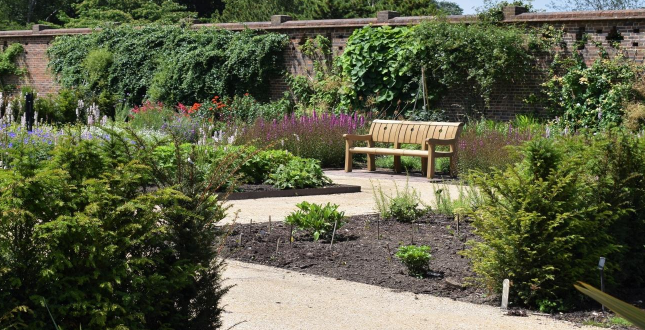- The new Agius Evolution Garden celebrates 350 million years of plant adaptation
- Advances in DNA analysis have uncovered surprising plant family connections
- A horticultural feast of visual beauty explores the story of plant evolution
Science and horticultural beauty meet at the Royal Botanic Gardens, Kew, in its newly designed Agius Evolution Garden, a celebration of 350 million years of adaptation fire protection to false flowers. Take a seat in this relaxing space and unravel the secrets held in the unique DNA of each species, as well as exploring new and surprising connections that have recently been discovered between species.
The science behind the garden…
Traditionally, plant species have been grouped into genera and families according to their physical characteristics. This has recently been proven to not always be accurate, as some plants may look similar but are not closely related. Today, Kew has the technology to look deeper into the fundamental building blocks of all living species: DNA. Kew’s work to unveil the Evolution Garden is now based on similarities in DNA and new insights into how plants and fungi have evolved through time. This knowledge could hold the key to developing new medicines or building climate-resilient cities.
Classification by DNA has given scientists some surprises. Plants thought to be unrelated because they didn’t share physical traits in common, such as;
- The London plane tree and the lotus flower are related
- Peonies are not related to buttercups, despite their similar flower structure
- The nettle family is surprisingly close to the rose family
The layout of the Agius Evolution Garden reflects Kew’s work in the global effort to uncover the Plant and Fungal Tree of Life. The framework that provided the inspiration for the design of this garden was created by the Angiosperm Phylogeny Group (APG), which has included several researchers from Kew. In 1998, the APG created the first DNA-based classification of plants, and several updates have been published in the intervening years, leading up to APG IV in 2016.
Professor Alexandre Antonelli, Director of Kew Science said, “Kew’s researchers have revolutionised our understanding of how the world’s plants are related. Studying the DNA of thousands of species, we now understand that nettles and roses are close relatives despite their striking differences, among many other surprises. The quest to piece together the Tree of Life continues – and is one of the most urgent projects in biology today. This garden illustrates Kew’s role in this vital work.”
What can you find in the garden…
The Agius Evolution Garden is divided into eight sections, separated by low yew hedges to form spectacular garden rooms. Closely related plants are grouped into plant families and related families are grown together in a garden room. The gorgeous horticultural displays set out in each room tell the compelling stories of plant evolution that hold fascinating facts and stories from the connection between strawberries and nettles to the Asteraceae family, of which almost all members have false flowers – heads of flowers that look like a single flower.
Richard Wilford, Evolution Garden Designer said, “This has been a fascinating design to lead and has certainly revolutionised the way I look at plant families after more than 30 years in Horticulture. One of the early discoveries arising from DNA analysis is that peonies are not related to buttercups, despite their similar flower structure, but are closely related to saxifrages and sedums. My hope is that visitors see not only the beautiful blooms of irises, pineapple lilies and daisies as they wonder through, but also delve into the science underpinning the design.”
Visitors can wander through each room of the garden learning surprising stories and enjoy the beautiful blooms of the daisy family (Asteraceae or Compositae) with Rudbeckia, Echinacea, Helianthus and Eupatorium all looking spectacular in late summer. As the garden becomes established, the different rooms will begin to show its own quirky and unique characteristics, highlighting the stark differences between each family.
The Agius Evolution Garden has been brought to life by the generous funding of Kew’s Chair of Trustees and his wife, Marcus and Kate Agius. As Marcus Agius steps down from ten years of service as the Kew’s Chair of Trustees this October, this garden will leave a beautiful legacy, reminding visitors for years to come of the importance of science and horticulture, and Kew’s vital work in both these fields.
Marcus Agius, Chair of Trustees, Kew said, “The Evolution Garden represents the ideal combination of horticulture and science – the two pillars on which Kew rests its reputation and its relevance. As the plants mature in coming years, I hope that this area will be one sought out for its visual beauty. More importantly, I hope that it will help Kew’s visitors to understand how plant life on earth has evolved and help to support Kew’s vital role in both science and education.”
 Gardeners Club The Gardeners Club is a free to join online club for everyone with an interest in gardening and gardens.
Gardeners Club The Gardeners Club is a free to join online club for everyone with an interest in gardening and gardens.






